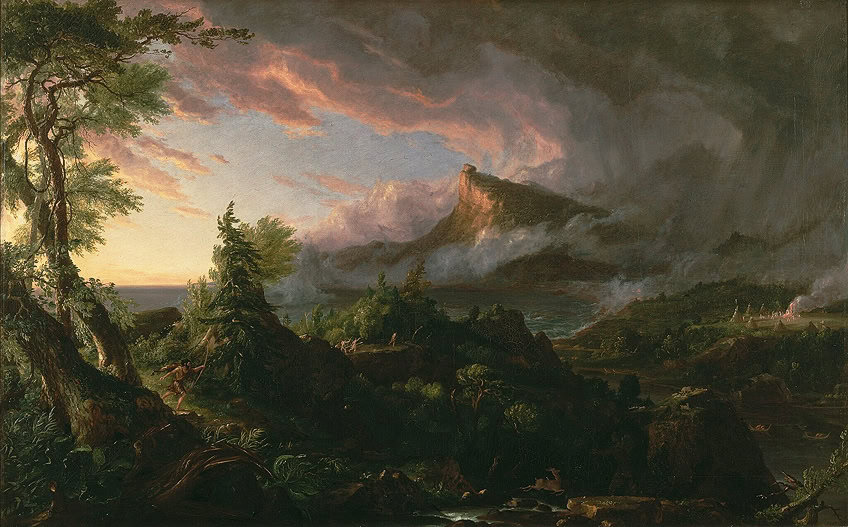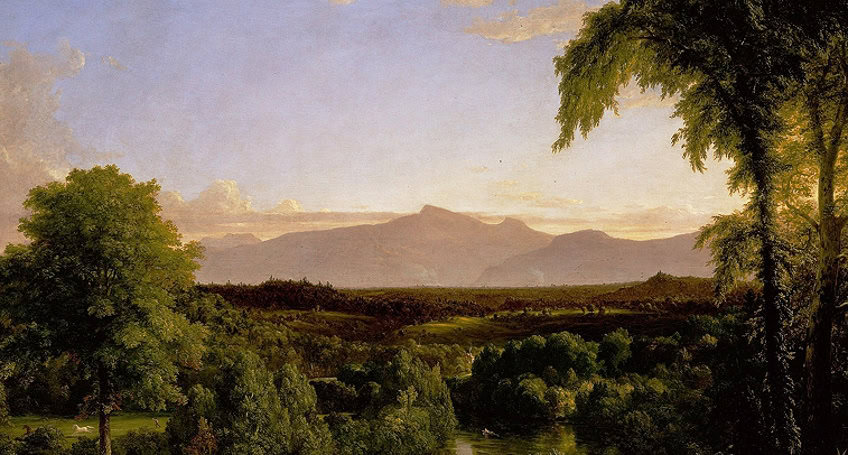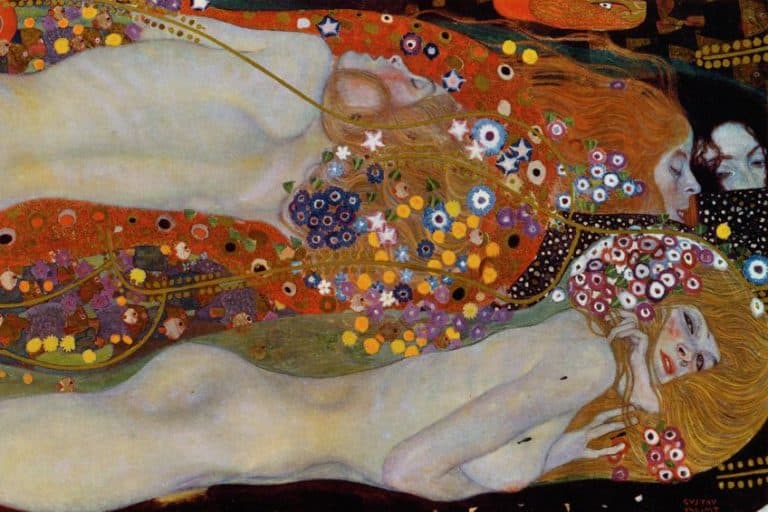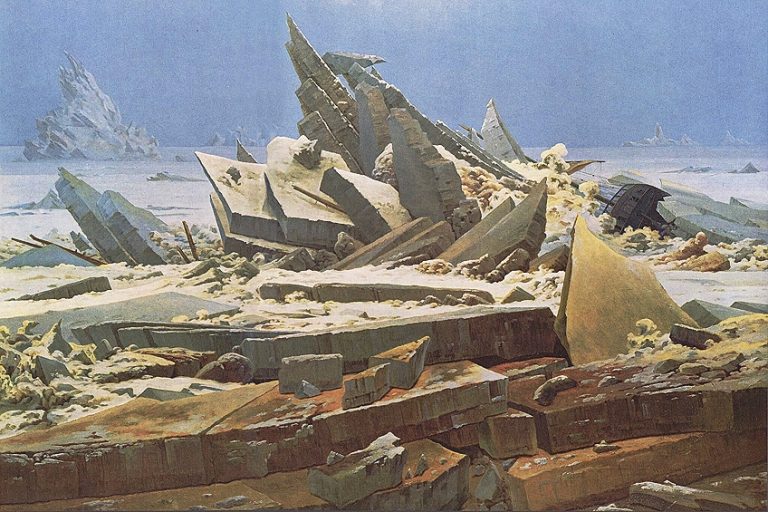“View on the Catskill – Early Autumn” by Thomas Cole – An Analysis
View on the Catskill – Early Autumn, painted by Thomas Cole in 1837, is a quintessential example of American landscape art during the 19th century. As the founder of the Hudson River School, Cole’s work is renowned for its meticulous detail, vibrant use of color, and profound sense of natural beauty. This painting captures the serene and picturesque scenery of the Catskill Mountains in early autumn, with a harmonious blend of warm autumnal hues and the tranquil, reflective water that showcases Cole’s deep appreciation for the American wilderness. Through this piece, Cole not only highlights the sublime beauty of the American landscape but also emphasizes the importance of preserving its untouched splendor in the face of increasing industrialization.
Key Takeaways
- The painting highlights Thomas Cole’s ability to detail natural landscapes.
- View on the Catskill – Early Autumn reflects 19th-century American wilderness.
- Inspired by the construction of the Canajoharie and Catskill Railroad.
Historical Context of the Artwork
| Artist | Thomas Cole (1801 – 1848) |
|---|---|
| Date Created | 1837 |
| Medium | Oil on canvas |
| Genre | Landscape |
| Period/Movement | Hudson River School |
| Dimensions (cm) | 99.1 × 160 |
| Series/Versions | Single version |
| Where Is It Housed? | The Metropolitan Museum of Art, New York City, United States |
| What It Is Worth | Not publicly auctioned; significant cultural and historical value |
Thomas Cole’s View on the Catskill – Early Autumn stands as a monumental piece within the Romanticism art movement. Created in 1837, Cole, an eminent American painter, masterfully uses oil on canvas to capture the serene beauty of the Catskill Mountains. This painting not only highlights Cole’s exceptional ability to detail natural landscapes but also provides a glimpse into 19th-century American wilderness. This piece was deeply inspired by the construction activities of the Canajoharie and Catskill Railroad.

Despite the changes brought by human activities, Cole’s work remains a tribute to the untouched beauty of his beloved Catskill wilderness. The painting’s dimensions contribute to its intimate yet expansive portrayal of nature. Through View on the Catskill – Early Autumn, Cole ushers viewers into a tranquil world, reflecting the delicate interplay between light and natural forms characteristic of his style. Cole’s dedication to showcasing the American landscape in its raw, unaltered state is what makes this artwork a keystone in his artistic legacy.
Composition and Elements
Thomas Cole’s View on the Catskill – Early Autumn illustrates the natural beauty of the Catskill mountains during the early 19th century. Known for his careful attention to nature, Cole often depicted serene landscapes untouched by industrialization. The painting was inspired by the Canajoharie and Catskill Railroad’s construction, suggesting the tension between development and nature’s fragility.
The inclusion of majestic trees, rolling hills, and a sweeping sky underscores Cole’s admiration for the American wilderness.
Color Palette and Techniques
Cole employed a vibrant and realistic color palette to highlight the changing seasons. Autumnal hues such as oranges, reds, and yellows dominate the canvas, capturing the transient beauty of early autumn. Using oil on canvas, he achieved detailed textures and depth. His technique of layering colors created a lifelike representation of the landscape. This approach was typical of the Romanticism movement, which emphasized emotion and individualism. Cole’s skillful use of light adds a dynamic element to the scene, making it appear almost three-dimensional.

Artistic Analysis of View on the Catskill – Early Autumn
Thomas Cole’s View on the Catskill – Early Autumn effectively captures the beauty and complexity of the natural landscape, blending meticulous detail with Romanticism’s emotional resonance. This analysis examines the subject matter, artistic techniques, and thematic elements present in the artwork.
Subject Matter
View on the Catskill – Early Autumn depicts a serene landscape scene. The painting displays the transition from summer to autumn in the Catskill Mountains. Cole includes detailed elements such as trees clothed in early autumn foliage, a quiet body of water, and distant mountains. The lack of human activity emphasizes the pristine and untouched nature of the setting, highlighting the wilderness. In the foreground, Cole’s precise brushwork brings attention to individual leaves and branches.
The middle-ground features rolling hills that guide the viewer’s eye deeper into the landscape, finally resting on the distant diffuse mountaintops.
Use of Color and Texture
The colors in the painting are vibrant yet natural, reflecting early autumn hues. The use of warm tones like oranges, yellows, and reds contrasts with lingering summer greens. Cole employs a variety of brushstrokes to create different textures. The leaves are painted with precise, short strokes, while broader, smoother strokes depict the water’s surface. The sky transitions seamlessly from light blue to soft pink, enhancing the tranquil mood of the scene. Light in this piece plays a crucial role, with bright patches illuminating parts of the landscape, creating depth and emphasizing nature’s brilliance.

Thematic Analysis
Romanticism is evident in Cole’s portrayal of nature as vast and sublime. The scene evokes a sense of awe and respect for the natural world, a central theme in his work. Contrasts between light and dark areas suggest the passage of time, reinforcing the idea of nature’s constant transformation. There’s an underlying message about the temporality of human life compared to the eternal cycle of seasons.
Cole’s focus on the wilderness reflects a yearning for the sublime, untouched by industrial progress, as he painted during a time when America’s landscape was rapidly changing.
Meaning of the Artwork
The painting carries a deeper meaning about the relationship between man and nature. Cole suggests an idealized natural world, pristine and unaltered by human presence, holding a mirror to the viewer’s role within it. There’s a subtle commentary on the importance of preserving the natural environment amidst growing industrialization. By omitting human figures and signs of human development, the piece invites introspection on the impact of civilization on nature. In essence, View on the Catskill – Early Autumn serves as both a celebration of and a lament for the purity of the American wilderness.

Exhibition and Location
View on the Catskill – Early Autumn by Thomas Cole is a significant work that is currently housed in one of the most renowned art institutions. Its display has influenced both art enthusiasts and scholars over the years, showcasing its lasting impression.
The Metropolitan Museum of Art
The painting View on the Catskill – Early Autumn” is part of the collection at The Metropolitan Museum of Art. Located in New York City, this institution is one of the largest and most prestigious art museums in the world. Visitors can appreciate Cole’s masterful depiction of the early autumn landscape. His attention to detail and use of light create an immersive experience. The museum’s collection highlights the importance of 19th-century American landscape painting. Cole’s piece is a prime example of how nature and art intersect.
The Romanticism movement, which Cole helped define, emphasized awe and beauty in nature.
Influence of View on the Catskill – Early Autumn Today
Thomas Cole’s influence extends beyond his time. His portrayal of natural beauty continues to inspire contemporary artists. The painting’s presence at The Metropolitan Museum of Art allows for ongoing appreciation and study. Modern landscape artists often cite Cole’s work as a foundation for their techniques. Art historians use his pieces to understand changes in American art and culture during the 19th century.
Public exhibitions and collections at the museum ensure that View on the Catskill – Early Autumn remains relevant. The continued display of the painting encourages dialogue about environmental conservation and the romanticization of nature. Such discussions are vital in the context of contemporary environmental issues.
Thomas Cole’s View on the Catskill – Early Autumn stands as a testament to the artist’s mastery of capturing the sublime beauty of nature and his role as a pioneer of the Hudson River School movement. Through his meticulous attention to detail and evocative use of color, Cole invites viewers into a tranquil world where the magnificence of the American wilderness is preserved in all its glory. This painting serves as a reminder of the importance of preserving our natural landscapes, echoing Cole’s own advocacy for the conservation of these cherished environments. View on the Catskill – Early Autumn not only captivates with its aesthetic charm but also resonates with a timeless message about the enduring value of our natural heritage.
Frequently Asked Questions
What Is the Historical Significance of View on the Catskill – Early Autumn Within the Hudson River School Art Movement?
Thomas Cole’s painting holds a crucial position in the history of American art, marking the early days of the Hudson River School. His focus on natural beauty and landscapes established a foundation for subsequent artists in the movement.
Can You Describe the Artistic Techniques Thomas Cole Used in View on the Catskill – Early Autumn?
Cole used detailed brushwork to depict the rich textures of the autumn foliage. He skillfully blended light and shadow to create depth and realism, capturing the serene yet vibrant essence of the Catskill wilderness.
How Does View on the Catskill – Early Autumn Reflect Thomas Cole’s Views on Nature and Industrialization?
The absence of the railroad in the painting signifies Cole’s reluctance to embrace industrialization. He emphasized the untouched, pristine beauty of nature, subtly critiquing the encroachment of industrial progress on the wilderness he cherished.
What Are Some Notable Symbols Present in View on the Catskill – Early Autumn and Their Interpretations?
The painting features symbols like the autumn leaves, representing change and the passage of time. The expansive sky and mountainous backdrop symbolize the vastness and enduring power of nature, juxtaposed against human progress.
Isabella studied at the University of Cape Town in South Africa and graduated with a Bachelor of Arts majoring in English Literature & Language and Psychology. Throughout her undergraduate years, she took Art History as an additional subject and absolutely loved it. Building on from her art history knowledge that began in high school, art has always been a particular area of fascination for her. From learning about artworks previously unknown to her, or sharpening her existing understanding of specific works, the ability to continue learning within this interesting sphere excites her greatly.
Her focal points of interest in art history encompass profiling specific artists and art movements, as it is these areas where she is able to really dig deep into the rich narrative of the art world. Additionally, she particularly enjoys exploring the different artistic styles of the 20th century, as well as the important impact that female artists have had on the development of art history.
Learn more about Isabella Meyer and the Art in Context Team.
Cite this Article
Isabella, Meyer, ““View on the Catskill – Early Autumn” by Thomas Cole – An Analysis.” Art in Context. June 18, 2024. URL: https://artincontext.org/view-on-the-catskill-early-autumn-by-thomas-cole-an-analysis/
Meyer, I. (2024, 18 June). “View on the Catskill – Early Autumn” by Thomas Cole – An Analysis. Art in Context. https://artincontext.org/view-on-the-catskill-early-autumn-by-thomas-cole-an-analysis/
Meyer, Isabella. ““View on the Catskill – Early Autumn” by Thomas Cole – An Analysis.” Art in Context, June 18, 2024. https://artincontext.org/view-on-the-catskill-early-autumn-by-thomas-cole-an-analysis/.











